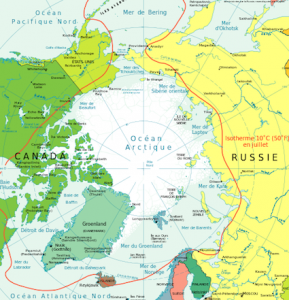In an article published by the French strategic and defense newsletter TTU on February 1, 2016, the evolving Russian strategy and the challenge for NATO and the United States is the focus of attention.
Entitled “The Arc of Steel and A2/AD,” the article identifies concerns with the evolution of Russian strategy and US responses to that strategy.
As a result of Russiaʼs surge in military strength in what a NATO admiral has called the “arc of steel” (from the Arctic to the eastern Mediterranean), the U.S. finds itself, on the short term, forced to review its global posture in terms of air and naval assets.
For the Pentagon, the challenge posed by anti-access/area denial strategies (A2/AD) is not only a concern with China in the Pacific. In the Atlantic, the eastern Mediterranean and the Arctic, Russia is deploying A2/AD means capable of hindering the operations of U.S. forces. At NATO, the issue is already on the agenda.
An inter-ministerial meeting in February will be devoted to the matter and several reports addressing it have already been produced.
For U.S. forces, the reinforcement of Russiaʼs military strongholds in the Far North, – bases, surface- to-air batteries, troops, etc. – has resulted in an unprecedented “anti- access/area denial” challenge, which neither the resources nor the current strategy of the U.S. are capable of countering.
On land, the situation is balanced, the U.S. army having a Stryker brigade in Alaska and a paratrooper brigade (soon to be transformed into a battalion) deployable anywhere in the Arctic using a C-17 or C-130. However, these units lack operational preparedness (landing on icy runways, for example).
As for the regular army, it is neither prepared nor equipped for this type of environment, contrary to Russian troops. At sea, while the U.S. navy has focused its strategy on the use of submarines, it has largely neglected surface means, notably when it comes to crucial ice breakers.
Beneath the surface, these are a U.S. advantage, both qualitatively and quantitatively: Seawolf-class submarines, the worldʼs most advanced, regularly patrol beneath the polar ice caps in the Bering Strait—a very discreet way of reaffirming the U.S.ʼs action capabilities while gathering intelligence.
But only two of these submarines are operating in the Arctic, as the programme was suspended at the end of the Cold War for budgetary reasons. Above water, Russia has a clear advantage.
The U.S. Coast Guard, whose resources in Alaska are limited (2,000 men, 52 ships and 17 aircraft), has only two ageing ice breakers capable of operating in winter.
The Russian government, on the other hand, has access to a fleet of 22 ice breakers and has launched construction of 11 more. These are dispersed means that could be regrouped into a task force in the event of a crisis.
This U.S. capabilities shortfall restricts the margins of manoeuvre of the U.S. navyʼs surface vessels, which moreover have only limited operational expe- rience in the region (aside from submarines). The U.S. navyʼs roadmap for the Arctic, revised in 2014, does not take into account the events in Ukraine nor recent Russian movements in the North, and still stipulates that the Arctic is a “low-risk environment in which an inter-state conflict is very unlikely.” As a result, resources have remained the same.
It may not be enough to maintain the U.S.ʼs ambitious goals: to protect American sove- reignty, have naval forces capable of operating in the region and preserving navigational freedom…the U.S. navy has however responded to the increased Russian submarine activity in the North Atlantic and Mediterranean: Admiral Richardson, head of the navyʼs operations, announced that a reinforcement of U.S. naval assets wherever Russia is present is currently under discussion.
The fact that a specialised Russian ship showed strong interest in U.S. underwater cables not long ago is likely a factor…
At the White House, officials have announced plans to strengthen the U.S. ice breaker fleet.
But this will have to wait until 2025 at the earliest, and will require supplementary funding.
The current U.S. Coast Guard budget (nine billion dollars) cannot cover such an investment (around one billion per vessel). Anti-access/area denial is also an issue in the air over the entire arc of steel, all the way to the eastern Mediterranean.
The commander of U.S. air forces in Europe, General Frank Gorenc, recently sounded the alarm regarding the gradual disappearance of the Westʼs military advantage.
The threat does not come from the air, where NATOʼs superiority is real, but from the ground.
In the Arctic, in Kaliningrad, in Crimea and in Syria, Russia is capable of putting in place multi-layered A2/AD zones that are difficult to penetrate, thanks to less expensive surface-to-air batteries that are available in greater numbers than aircraft.
If the United States is working on adapted long-term technological solutions, on the shorter term, two solutions are available to America and its allies.
First, stealth aircraft, with the planned bolstering of their numbers in Alaska (F-22 and F-35) and in the U.K (British F-35 and two U.S. squadrons in 2020). Gorenc also plans to possibly deploy the F-22 in Europe.
According to him, the survivability of generation four and 4.5 aircraft (Rafale, Eurofighter…) will depend on the adoption of and training for tactics, techniques and procedures (TTP) adapted to this threat.
Another avenue being considered, called RAPID X, aims to increase the mobility of allied aircraft through an extended network of NATO bases, in order to limit the impact of possible Russian strikes.




Leave a Reply